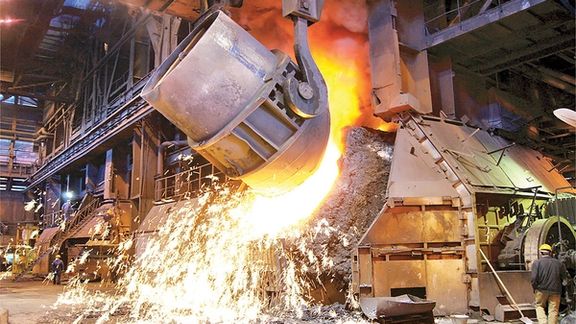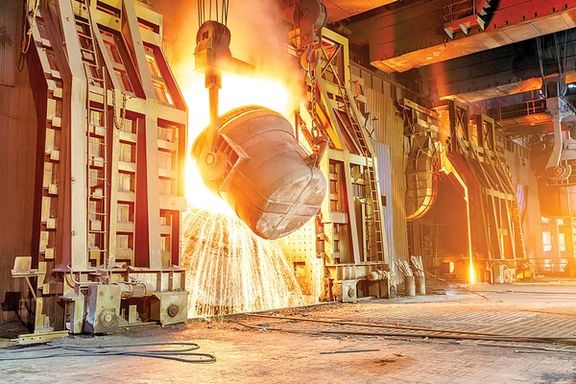Exclusive: Large Steel Works In Iran Down Due To Power Shortage

Amid the ongoing power shortage crisis in Iran, Khuzestan Steel Company has been forced to halt operations and put workers on mandatory furloughs.

Amid the ongoing power shortage crisis in Iran, Khuzestan Steel Company has been forced to halt operations and put workers on mandatory furloughs.
According to information obtained by Iran International the shutdown of Iran’s second biggest steel producer started a week ago following several weeks of reduced operations due to persistent electricity outages.
According to an informed source, each day of the shutdown results in a substantial loss of around $15 million. Khuzestan Steel Company is in southwestern Iran near Ahvaz, the provincial capital of oil-rich Khuzestan province, whose residents are grappling with regular power outages in the midst of one of the worst heatwaves in recent history.
The company's CEO Amin Ebrahimi told IRGC-affiliated Fars news agency Thursday that the plant is undergoing regular repair and maintenance at the moment, but he did not confirm the shutdown. He cited the Energy Ministry as announcing a 29% increase in electricity supply to steel plants, claiming that this will result in a boost in production.
Earlier in the year, reports by industry sources revealed that steel production in Iran had plummeted because the country faced a severe shortage of electricity and gas, both vital for running the plants. Iranian industrialist Reza Shahrestani said In January the steel industry needed 40 million cubic meters of gas daily, but their consumption was at 15 million cubic meters per day at the time. He added that almost 50% of the electricity supply for industries has been cut off too.
The World Steel Association, in its March report, removed Iran from the list of the 10 largest steel producers in the world. Iran has always been among the top 10 in the world, and in the first two months of 2023, Iran was the ninth largest steel producer ahead Turkey.
Economist Ahmad Alavi told Iran International that the total loss from the shutdown of Khuzestan Steel Company is not limited to the estimated $15-million because there are a lot of other businesses in different sectors that depend on the steel industry and will suffer losses. He added that the poor infrastructure in the steel industry – as well as other industries – is a result of decades of mismanagement and lack of investment, therefore the regime will not be able to resolve these issues in the near future.

Germany-based journalist Ata Hosseinian told Iran International that the shutdown is only one of the many consequences of the disparity between power generation and consumption. He added that now the power shortage in the country is not only impeding small businesses or plants but also damaging key industries.
In early August, Iran implemented a two-day shutdown of businesses and factories nationwide, initially presented as a health safety measure. However, it was later revealed that it was an excuse to deflect attention from the ongoing electricity, gas, and water shortages.
Payam-e Ma newspaper cited an informed yet unnamed source from the Energy Ministry as saying that the reason behind the shutdown was the country's electricity shortages. The constant rise in temperatures and decrease in rainfall across the country in the last decade have made electricity supply a challenge during peak consumption periods that happen in summers and winters. In July, Iran’s electricity usage hit a record of 72,500 megawatts, increasing the strain on power grids that were already struggling to meet demand.
"High temperature and increased electricity consumption in the past days have led the hydroelectric power plants of Karun-3 and Karun-4 dams – on the Iranian river with the highest water flow -- to produce electricity beyond their nominal capacity," the daily said. The power plants were reportedly generating electricity for more than 20 hours per day in the past several days, leading to a "depletion of water resources," which caused the plants to "temporarily cease production."
Power plant capacity and fuel supply are both inadequate to meet demand, and blackouts regularly happen in summer. Even so, Iran exports electricity to Iraq. Iran's electricity grid is overstretched and has failed to realize its annual growth plan for several years in a row, while consumption continues to grow, in part driven by extremely low prices. It is in dire need of significant investment and technological upgrade, which have been hindered for years by sanctions imposed because of Iran’s nuclear and missile programs.
Iranian environmentalist Kaveh Madani -- the former deputy head of Iran's department of environment who heads the United Nations University Institute for Water, Environment and Health, posted on X on Wednesday, stating that Iran’s bankruptcy of water, electricity, and gas cannot be solved by simply shutting down the country.